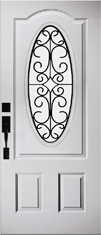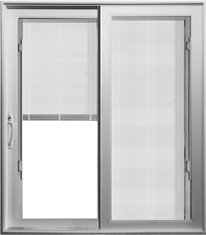NORTHEAST BUILDING PRODUCTS CORPORATION
PRODUCT CARE GUIDE
CARE AND CLEANING INSTRUCTIONS
WINDOWS | SLIDING GLASS DOORS | ENTRY DOORS
CARE AND CLEANING YOUR VINYL WINDOWS AND SLIDING GLASS DOORS
Cleaning windows means more than just cleaning glass. With only simple care and cleaning, your windows and sliding glass doors can keep their beautiful appearance for years. Like any surface exposed to outside elements, your windows and doors will get dirty over time, but cleaning them is rather simple. Here are some helpful tips for cleaning your vinyl windows and sliding glass doors effectively without damaging them.
Vinyl
- Make sure to vacuum any dirt or sand from sill track areas before washing.
- Test any cleaner on an inconspicuous area first.
- Use a mixture of mild dish soap (such as Palmolive®) mixed with water for cleaning of vinyl frames. Do NOT clean the windows or doors with a high-pressure washer. The extreme spray pressure could crack or destroy the caulking around the windows or doors.
- Rinse completely with clear water and wipe dry.
- Make certain that drainage or “weep” holes are clear of dirt or obstructions both inside and outside of the window frame.
- Use of a Magic Eraser® is recommended for scuff marks and crayon on the vinyl.
- DO NOT USE liquid grease remover, strong soaps or detergents containing organic solvents, nail polish remover, furniture polish or cleaners containing chlorine bleach. These items could affect the surface appearance of the vinyl.
Glass
- Glass care is VERY IMPORTANT and requires proper maintenance. Avoid cleaning glass in direct sunlight.
- Rinse completely with clear water and wipe dry with a soft cloth.
- Ammonia-free cleaners such as Windex® also produce good results.
- DO NOT USE any petroleum-based cleaners or caustic chemicals to clean the glass
- DO NOT USE a razor blade, putty knife or any abrasive pad to clean glass.
- DO NOT CLEAN GLASS WITH A HIGH-PRESSURE SPRAY WASHER. THE EXTREME SPRAY PRESSURE COULD DAMAGE THE GLAZING AND DESTROY THE SEAL OF THE INSULATING GLASS UNIT.
- DO NOT add attachments to window or glass.
Screens
- For routine cleaning carefully vacuum your screens.
- To thoroughly clean your screens, remove the screen from the window frame. Place on a flat surface and wash with mild soap and water. Use a soft brush (if needed) to remove dirt and grime. Clean both sides of the screen around the interior and exterior of the frame. Rinse off with clean water, wipe dry or allow to dry completely before reinstalling in the window.
- DO NOT USE a high-pressure spray. It will cause damage, rip screens and jeopardize window seals.
R5 WINDOWS WITH AGC COMFORT SELECT™ 73 LOW E GLASS
- AGC Comfort Select™ 73 is a pyrolytically coated (hard coat) low emissivity glass. The coated surface is very durable and has a slight texture inherent on this type of coated glass. Hand cleaning of Comfort Select™ 73 is different than cleaning of non-coated glass. Following the recommendations below will result in successfully cleaning Comfort Select™ 73.
- It is very important to read all care instructions before cleaning your high energy efficient R5 windows with Comfort Select™ 73 Low E Glass. Special care is needed to maintain the beauty and performance of your new windows.
- Hand Cleaning Recommendations
- NEVER use any type of razor blade, scraper, plastic or metal, on the coated surface. Remove rings and any other items that may come in contact with the coated glass while handling.
- Thoroughly clean the surface of the glass with a clean sponge or soft cloth and plain water to remove surface contaminates.
- Dry with a clean soft cloth. Use a clean sponge or soft cloth to wash the surface with a solution of 10% to 20% white vinegar with clean water. Always use a new soft cloth or squeegee to dry the glass. Cleaning may cause streaks when dried if the glass is exceptionally dirty. In this case, repeat cleaning. Care should be taken with rubber squeegees as they can leave streaks that are extremely hard to remove if they are used incorrectly or in poor condition.
- Commercial glass cleaners (Windex®, Glass Plus®, etc.) may be used, but some may leave a film residue and may cause smearing. If these situations occur repeat the cleaning process using vinegar based cleaner. Vinegar based cleaners tend to cause less streaking than other types of cleaning solutions. The most important consideration is to remove as much contamination from the coating as possible with the plain water wash before attempting final cleaning.
Special Cleaning
For unusually hard to remove contaminates such as crayons, wax, grease, markers and adhesives, special cleaners may be used to spot clean the glass. Denatured alcohol and isopropyl alcohol work on a variety of contaminates. For harder to remove contaminates such as crayons and markers, commercially available cleaners such as Goo Gone® and Goo Off® work well. After spot cleaning, the full glass surface should be cleaned as discussed above.
Continued Smooth Operation
- To ensure that your vinyl windows and sliding glass doors continue to open, close, lock and unlock easily, follow these helpful tips.
- Moving parts in hardware components and tracks should be lubricated periodically using a non-detergent lubricant such as 3-IN-ONE® multipurpose oil or lithium grease. If you are in a salt air environment, this can mean cleaning as well as lubricating monthly.
- Check weather-stripping around all operable panels to make sure it seals evenly.
- Check and clean weather-stripping by lightly brushing the pile.
- Make sure tracks are kept clean by vacuuming to clear any dirt, sand or debris.
Check windows and doors annually and re-caulk as needed.
CARE AND CLEANING YOUR ENTRY DOOR
Doors
- Keep doors clean. Dust, soil and pollutants such as pollen on the paint or stain surface will hold moisture and accelerate finish failure.
- To clean doors, use a clean rag or paper towel and mild dish soap and water. Then rinse gently with clean water and wipe dry.
- NO POWER WASHING
- Keep threshold clean of dirt and grit with mild dish soap and water, wipe clean with clear water, and wipe dry.
- Keep weather-stripping clean of dirt, debris, grit, and pollen for proper seal. Wash with mild dish soap and water, rinse with clear water, wipe dry with clean cloth or paper towel.
- If finish is accidentally scratched or chipped, clean as recommended above and use touch-up paint or stain supplied with door. Be sure to shake touch up bottle for a minute to blend the paint. Try the touch up
- in an inconspicuous place to verify color match.
Glass
- Wash and clean your glass with a streak free, ammonia free glass cleaner. Do not spray directly on the glass.
- Spray or pour cleaner onto a clean towel or rag, rather than directly onto the glass, to prevent cleaner from dripping and/or running down into channels and causing premature aging and seal failure of the insulated glass.
Hardware
After installation of the hardware, gently rub off any excess oil that remains on the exterior components using a clean dry terry towel or cheesecloth. Periodically cleaning the hardware with water and mild dish soap will help
provide for a long-lasting finish. You can polish your hardware using a non-abrasive automotive or furniture wax which can be used on the hardware only. Spraying onto a clean rag, rather than directly on the hardware will prevent overspray on the door finish. Liquid graphite or sewing machine oil can be sprayed into the cylinder (keyway) and the latch. DO NOT USE commercial lubricants such as WD-40. These lubricants contain surfactants that you
would not want to be in constant contact with your skin. Basic soaps and oils are better for skin contact with most people.
Tighten screws on locksets and hinges when necessary.
Caution:
- DO NOT USE paint thinners, lacquer thinner, acid wash, gasoline, kerosene or any other harsh chemicals to clean surfaces of the door, frame, threshold or hardware.
- DO NOT EVER power wash your door.
- DO NOT apply tape, suction cups, or stickers on the door surface. These can cause finish failure that is not covered by our warranty.
- Drilling into steel doors to hang curtain rods, house numbers, name plaques, etc. is not recommended and will void our warranty.
CONDENSATION AND MOLD
- Condensation can be a natural occurrence and may be a warning that too much moisture is present and could cause structural deterioration and the potential of mold growth. It is not considered a defect of the window or door.
- Water or frost on windows is condensation.
- Condensation on the inside of a window or door is a result of a higher air moisture content contacting the lower temperatures on the glass or vinyl. Higher interior humidity and a lower outside window temperature can cause
- condensation. An example of this is when a bathroom mirror “steams up” after a hot shower. Just like that mirror, the inside or outside of your window can sweat or fog because of temperature differentials.
- Excessive interior humidity can cause structural damage and health concerns if high moisture levels are sustained inside wall cavities. Wood rot, mold and mildew may result.
- Use exhaust fans, especially when showering.
- Install and use a dehumidifier and ceiling fans to circulate air.
- Open drapes and blinds, allowing air to circulate against windows.
- Periodically open windows and doors whenever practical to allow interior moisture to escape.
- If you didn’t have as much condensation before replacing your old windows, it’s probably because they were drafty. Good windows and insulation all create barriers to the air exchange of a home.
- If you find condensation between the two layers of glass in an insulated window, the airtight seal has probably been broken and the glass will need to be replaced.
Outdoor Condensation
Under some climate conditions condensation may occur on the exterior surface of a window or door. This is more likely to occur on higher-performance windows with Low E coatings and low-conductance gas fills that create very low factors. For exterior condensation to occur, the glass temperature must be below the outdoor dew point temperature. This is most likely to happen when there is a clear night sky, still air and high relative humidity, in addition to the right temperature conditions. Like other dew formed at night, exterior window condensation will disappear as surfaces are warmed by the sun. It is the excellent thermal performance of the well-insulated glazing that creates the condition where the outer glass surface can be cold enough to cause condensation to form.



























